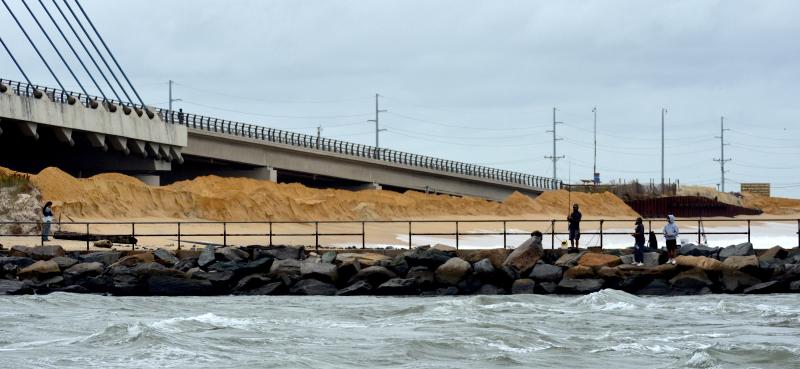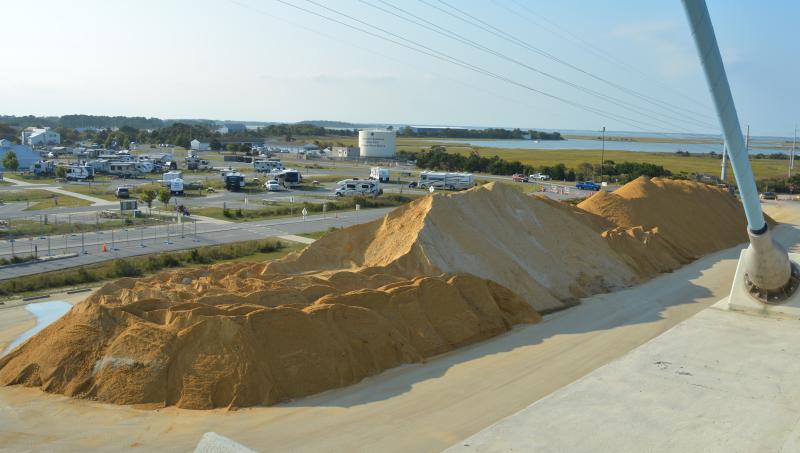DNREC proposes even more sand for inlet beach
In an effort to fully build back the beach immediately north of the Indian River Inlet, the state’s environmental agency has increased the recommended amount of sand to be dredged from 550,000 cubic yards to 800,000.
Delaware Department of Natural Resources and Environmental Control announced earlier this month that it will undertake a major dredging and beach nourishment project this winter to rebuild the inlet’s north beach and protect critical infrastructure. Now, the state agency has modified the original amount by more than 200,000 cubic yards because that’s what it will take to restore the beach to how it looked in 2013, the last time the area had such a large influx of sand.
Twice since March, storm-related winds and high tides have pushed ocean waters over the dune and into the northbound lanes of Route 1. On both occasions, the northbound lanes were closed for hours, forcing motorists to detour all the way around Indian and Rehoboth bays.
DNREC conducted an information session on the upcoming project Sept. 24 at Bethany Beach Town Hall. Boards were set up around the room showing the history, current situation and the anticipated future of the beach north of the inlet.
Sen. Gerald Hocker, R-Ocean View, was in attendance. He said this has been an ongoing issue, but it’s fallen on deaf ears because DNREC has had a secretary who hasn’t given it much thought.
“We’re lucky this wasn’t much worse, and now they’re panicking to do something,” said Hocker.
Hocker said the state needs to come up with a long-term solution. The first major storm is going to wash the sand away and then it will be closed until the riprap is cleared out, he said.
The design of the inlet is flawed and it needs to be fixed, said Hocker, adding that he’s trying to get the U.S. Army Corps of Engineers to help. There needs to be something to break up the wave action, and long jetties need to be installed to keep the sand from moving, he said.
“We’re dealing with Mother Nature, and it needs to be dealt with the right way,” said Hocker.
Sen. Russ Huxtable, D-Lewes, was also in attendance at the town hall. He said people can always look back at what hasn’t been done, but the issue is being addressed now.
“This is a robust approach to fixing the problem now, knowing there will be more work to be done in the future,” said Huxtable.
In addition to the beach restoration project, the Delaware Department of Transportation will install 665 linear feet of 30-foot-tall sheet pile. The new sheet pile will be tied into existing sheet pile.
There are time-of-year restrictions to protect animals that limit DNREC to dredging from Oct. 1 to Feb. 28. The expectation is that DNREC will move between 300,000 and 500,000 cubic yards of material this winter, with any additional material occurring as a second phase to the project.
DNREC continues to say that the sand bypass system, which has not been operational since before COVID due to issues surrounding a conversion from diesel to electric engines, will be working in December. The bypass pumps sand from the south side of the inlet to the north side. The system will not operate during the nourishment project.
Looking to the future, DNREC is aiming to pump up to 100,000 cubic yards annually.
The estimated cost of the project is $15 million, with funding coming from the governor’s office. There is an additional $10 million committed from the Army Corps for future phases and long-term efforts.
Chris Flood has been working for the Cape Gazette since early 2014. He currently covers Rehoboth Beach and Henlopen Acres, but has also covered Dewey Beach and the state government. He covers environmental stories, business stories and random stories on subjects he finds interesting, and he also writes a column called Choppin’ Wood that runs every other week. He’s a graduate of the University of Maine and the Landing School of Boat Building & Design.


















































